2022.7: A stunning performance

Home Assistant Core 2022.7! ☀️
This was one exciting and busy month! In case you’ve missed it, there was
a Matter in Home Assistant workshop
Meanwhile, preparations are happening for the upcoming Matter and of course, the soon-to-be-released Home Assistant Yellow! 💛 More about that soon™.
This release is definitely representing the “streamlining experiences” motto we have been using. The performance improvements in this release are once more: stunning! Furthermore, there are some wonderful new features to explore too.
This release has the perfect mix! I’m sure there is something in here you like. So without further due: Enjoy the release!
../Frenck
- Improved stability and performance, and Python 3.10
- Update Z-Wave devices directly from Home Assistant
- The about page is now beautiful too!
- Change any weather unit to your preference
- Labels instead of values for gauge cards segments
- Code editors now auto-complete MDI icons
- Filter the history panel
- Easily convert values to booleans in templates
- Other noteworthy changes
- New Integrations
- Integrations now available to set up from the UI
- Release 2022.7.1 - July 7
- Release 2022.7.2 - July 8
- Release 2022.7.3 - July 10
- Release 2022.7.4 - July 13
- Release 2022.7.5 - July 14
- Release 2022.7.6 - July 20
- Release 2022.7.7 - July 26
- Need help? Join the community!
- Backward-incompatible changes
- Farewell to the following
- All changes
Don’t forget to join our release party live stream on YouTube
Improved stability and performance, and Python 3.10
The quest to improve the performance of Home Assistant continues. For many
releases, @bdraco
Usually, we have a section at the end of our release notes informing you about the performance improvements made. The improvements in this release, however, are a big deal.
Our YAML & JSON tooling improved, using faster libraries and methods. JSON is used internally and for communication with the frontend, which is A LOT snappier now. If you use lots of YAML, you will undoubtedly notice this when starting Home Assistant or reloading things like your automations 🚀.
Devices with an integration error during startup that can self-recover will now do that instantly as soon as the device is discovered.
We now use a better and faster encryption method for the HomeKit Accessory Protocol (HAP). It improves the performance of the HomeKit, HomeKit Controller, and Apple TV integrations and prepares Home Assistant for iOS 16.
Lastly, @pvizeli
Update Z-Wave devices directly from Home Assistant
All software has bugs, including the software on your Z-Wave devices. But how to update those? Have no fear! As of today, we have a solution for this!
Thanks to the hard work and collaboration between @AlCalzone
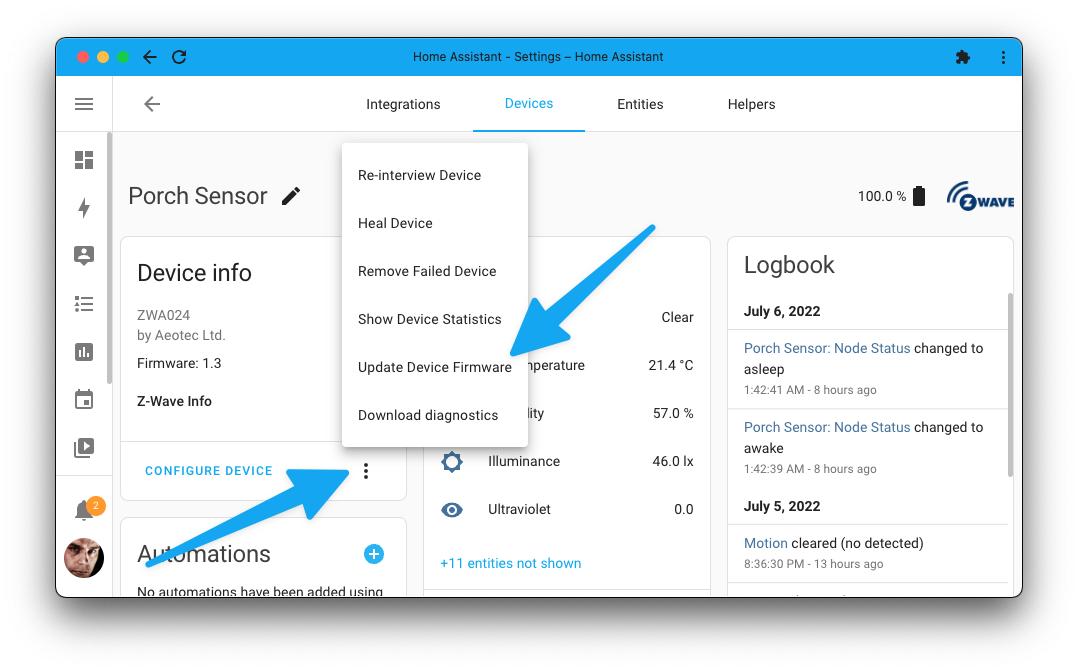
On the device page of your Z-Wave device, there is now a menu item allowing you to install Z-Wave firmware updates onto your device manually.
Get a software update for your Z-Wave device from the manufacturer, and start an update in Home Assistant, which allows you to upload the update file you got from the manufacturer. The rest is pure magic!

During update installation, you’ll be presented with the update’s progress.
It is that easy 💪
The about page is now beautiful too!
Have you ever looked at the about page in the Home Assistant settings menu?
It was probably one of the least visually appealing pages still in our menus,
and @zsarnett
It now clearly shows the versions of the different components your instance is made up of, and provides a clean menu to all kinds of Home Assistant related links.
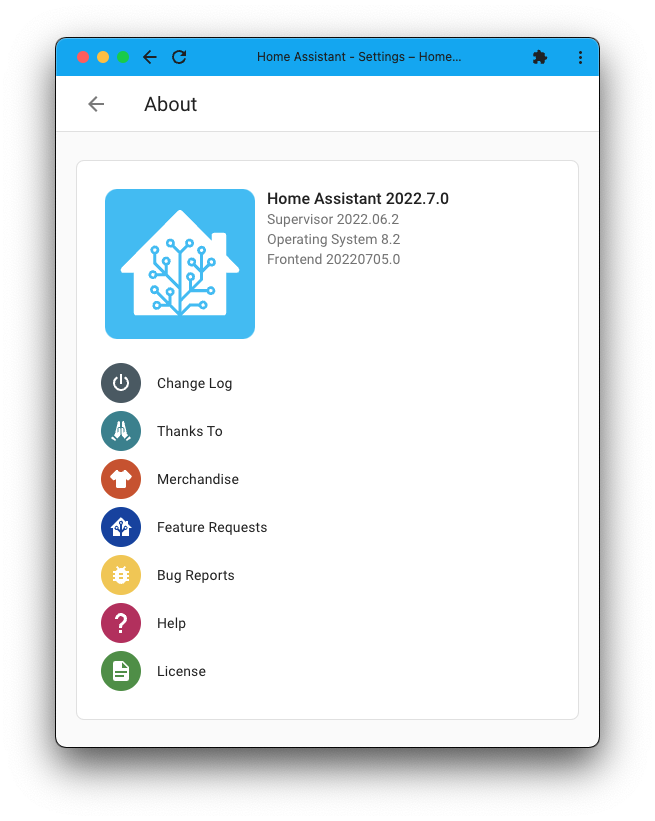
Change any weather unit to your preference
Home Assistant has many weather services that can be integrated; it is great to have a choice! The differences between those are often their accuracy for your region and the units of measurement used for the different weather data points.
But what if you’d like the barometric pressure unit to be in mbar instead of hPa? Or maybe use m/s or knots instead of km/h for wind speed? No problem!
You can now change the units each weather entity uses! Not just temperature, but for all of the values a weather entity provides. When changing a unit, Home Assistant will take care of converting the values for you.
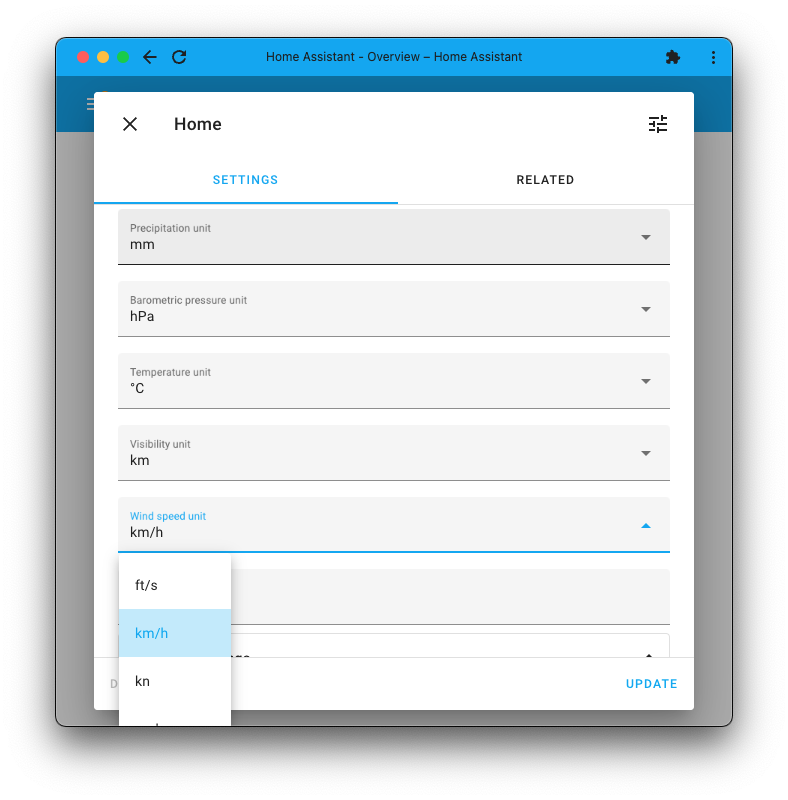
On a similar note, number entities that represent a temperature are now converted to the temperature unit used by the configured unit system.
Thanks @emontnemery
Labels instead of values for gauge cards segments
When displaying an entity gauge card on your dashboard, it would show the gauge with the sensor value. For example, if you’d use a humidity sensor, it shows the humidity percentage in the middle of the gauge.
In the 2022.5 release, we added segment support to our gauge card.
In this release, @kristjanbjarni
This means that if your segment has a label, the gauge card will show that label instead of the sensor value when it is in that range.
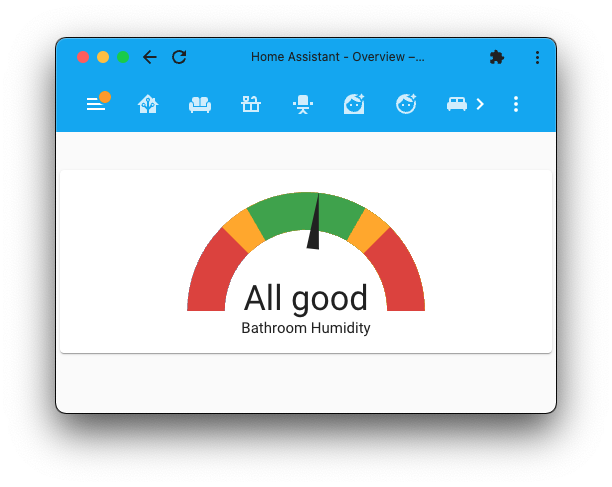
For more information, check out our gauge card documentation.
Code editors now auto-complete MDI icons
All of our code editors in the frontend now have auto-completions for
MDI icons. Just start typing mdi: and it will help you find the exact icon
you need.
Like the normal icon picker, it supports searching on parts of the icon name, its aliases and categories. Additionally, it will show a little preview of the icon you are about to select, so you know you got the right one.
Thank you @bramkragten
Filter the history panel
If you have lots of devices and entities then the
history panel can be long! Actually,
it would become so large, that it becomes unpractical. You could always
filter it down to a single entity, but that is fairly limited as well.
For this release, @D3v01dZA
The history can now be filtered by one or more entities, by all entities of one or more areas, or by all entities of one or more devices.
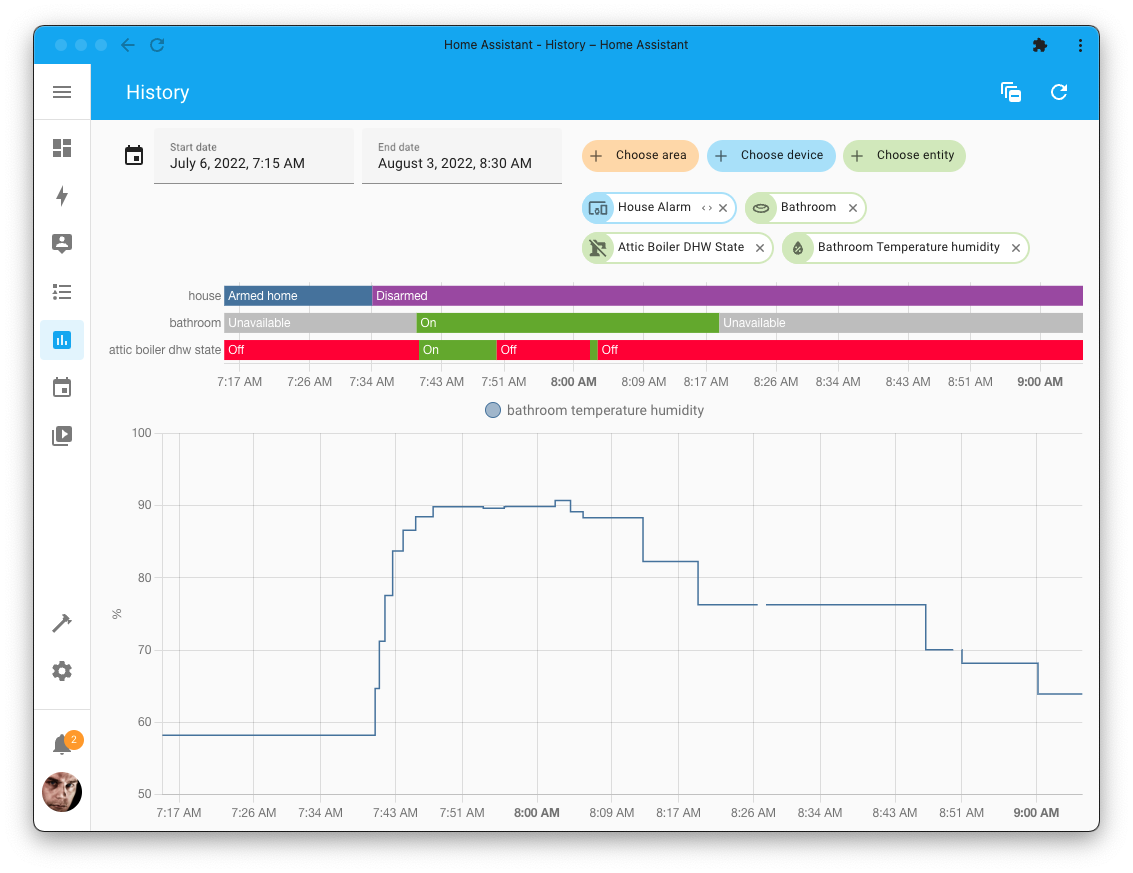
This is super helpful, as you can now view the history of all entities in, for example, your living room area quick and easy.
Easily convert values to booleans in templates
If you are into templates, @pyosbool
function that can be used as a filter too!
If you are a bit into coding, this is not the standard bool(), but one that
is very specific for Home Assistant, making it very useful.
This bool method converts a value into a boolean and considers
Home Assistant’s specific rules for truthy values. Some examples: "on" will
be considered true, and "disabled" will be considered false.
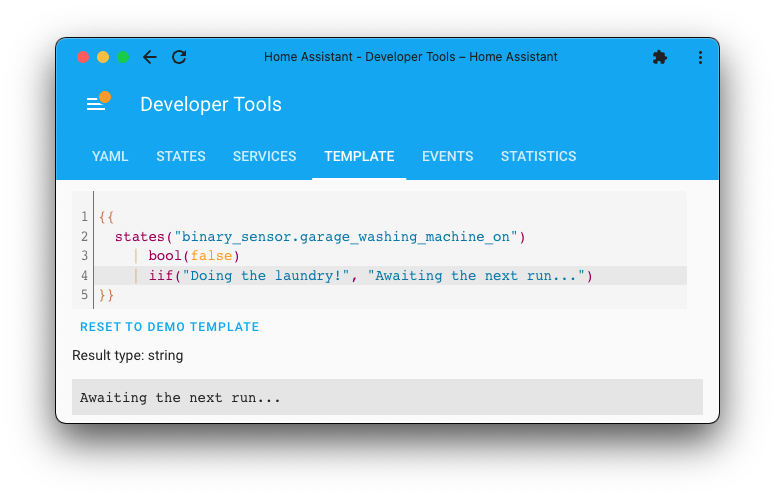
Using bool as a filter and combined with and iif
filter, you can quickly change, for example, binary sensors values into any
text you’d like.
For more information, check out our Templating documentation.
Other noteworthy changes
There is much more juice in this release; here are some of the other noteworthy changes this release:
- The Material Design Icons have been updated to v6.9.96, giving you
100
and another 100 brand new icons to use 🤩 . - You can now control the loudness and various additional surround-related
settings of your Sonos speakers, thanks @jjlawren
! 🔊 - You can now trigger Alexa routines from switches, toggles, and buttons
without the need to wrap them into a binary template sensor first.
Fantastic addition, @mdegat01
! - The logbook live feeds will now automatically pause when you start
scrolling and resume when you are back at the top again. Thanks, @bdraco
! -
@matrixd2
extended YoLink; It now supports thermostats, valve controllers, locks, and vibration, CO, and Smoke Sensors! -
Jellyfin now supports movie collections in the media browser, thanks @j-stienstra
! - Thanks to @dmulcahey
, the widely discussed Aqara FP1 sensor is now supported by ZHA! -
@ghedo
has been busy improving the Area Card. It can now show moisture/flood alerts, humidity, and shows an icon for temperature. Nice! -
@kingy444
added support for Top/Down, Bottom/Up to Hunter Douglas PowerView. Additionally, buttons to calibrate and jog (identify) have been added. @bdraco added support for polling in case the device is mains powered. - Thanks to @thrawnarn
, you can now send polls via Telegram bot! - The Home Connect integration now has whole collection of new services
that can be used to control and configure options of device programs.
Really nice, @BraveChicken1
! - If you have WiZ power plugs with power monitoring, these are now supported,
thanks to @bdraco
⚡️. -
@gjohansson-ST
added lots of love to Sensibo this release. Support for (split) timers, Pure Boost, improvements to setting temperature, bug fixes, and many more. Nice work! -
@iAutom8
made his first-time-ever open source contribution ❤️; And added support for additional temperature sensors in ViCare.
New Integrations
This release does not include new integrations.
Integrations now available to set up from the UI
The following integrations are now available via the Home Assistant UI:
-
Eight Sleep, done by @raman325
-
Radio Thermostat, done by @bdraco
-
Simplepush, done by @engrbm87
-
SkyBell, done by @tkdrob
Release 2022.7.1 - July 7
- Bump deCONZ dependency to v96 (@Kane610
- #74460 ) (deconz docs) - Bump satel_integra to 0.3.7 to fix compat with python 3.10 (@c-soft
- #74543 ) (satel_integra docs) - fjaraskupan: Make sure we stop bleak on home assistant stop (@elupus
- #74545 ) (fjaraskupan docs) - Minimize Sonos
media_player.unjointimeout (@jjlawren- #74549 ) (sonos docs) - Bump aioskybell to 22.7.0 (@tkdrob
- #74559 ) (skybell docs) - Bump pyenvisalink version to 4.6 (@ufodone
- #74561 ) (envisalink docs) - ElkM1 bump lib to support Python 3.10 SSL (@gwww
- #74569 ) (elkm1 docs) - Fix openweathermap hourly forecast (@emontnemery
- #74578 ) (openweathermap docs) - Fix mix of aiohttp and requests in Bloomsky (@frenck
- #74598 ) (bloomsky docs) - Update aiokafka to 0.7.2 (@frenck
- #74601 ) (apache_kafka docs) - Poll cast groups when media player is added or reconnected (@emontnemery
- #74610 ) (cast docs) - Ikea Starkvind support all models (@arnemauer
- #74615 ) (zha docs) - Update frontend to 20220707.0 (@bramkragten
- #74625 ) (frontend docs) - Fix mix of aiohttp and requests in ZAMG (@frenck
- #74628 ) (zamg docs) - Fix smart energy polling for Tuya plugs (@TheJulianJES
- #74640 ) (zha docs) - Fix exception in doorbird logbook during startup (@bdraco
- #74649 ) (doorbird docs) - Update kaiterra-async-client to 1.0.0 (@Michsior14
- #74677 ) (kaiterra docs)
Release 2022.7.2 - July 8
- Add missing strings for here_travel_time (@eifinger
- #74641 ) (here_travel_time docs) - Add ssh-rsa as acceptable an host key algorithm (@siyuan-nz
- #74684 ) (unifi_direct docs) - Fix ZHA group not setting the correct color mode (@TheJulianJES
- #74687 ) (zha docs) - Bump deconz dependency to fix #74523 (@Kane610
- #74710 ) (deconz docs) - Bump atomicwrites (@balloob
- #74758 ) - Bump regenmaschine to 2022.07.0 (@bachya
- #74680 ) (rainmachine docs) - Fix error with HDD temperature report in Freebox integration (@BenoitAnastay
- #74718 ) (freebox docs)
Release 2022.7.3 - July 10
- Fix Vicare One Time Charge (@oischinger
- #74872 ) (vicare docs) - Fix KeyError from zwave_js diagnostics (@kpine
- #74579 ) (zwave_js docs) - Update systembridgeconnector to 3.3.2 (@timmo001
- #74701 ) (system_bridge docs) -
air_qualityandfilter_lifefixes for Pur131S (@jetpacktuxedo- #74740 ) (vesync docs) - Update pyCEC to version 0.5.2 (@inytar
- #74742 ) (hdmi_cec docs) - Bump pyezviz to 0.2.0.9 (@regevbr
- #74755 ) (ezviz docs) - Update aioqsw to v0.1.1 (@Noltari
- #74784 ) (qnap_qsw docs) - Bump python-gammu to 3.2.4 with Python 3.10 support (@PaulAnnekov
- #74797 ) (sms docs) - Bump deCONZ dependency to fix #74791 (@Kane610
- #74804 ) (deconz docs) - Bump regenmaschine to 2022.07.1 (@bachya
- #74815 ) (rainmachine docs) - Fixed unit of measurement. #70121 (@StephanU
- #74838 ) (edl21 docs) - Bump rokuecp to 0.17.0 (@ctalkington
- #74862 ) (roku docs) - Bump pymazda to 0.3.6 (@bdr99
- #74863 ) (mazda docs) - Fix Vicare One Time Charge (@oischinger
- #74872 ) (vicare docs) - Bump pysml to 0.0.8 (fixes #74382) (@DavidMStraub
- #74875 ) (edl21 docs) - Bump afsapi to 0.2.5 (@wlcrs
- #74907 ) (frontier_silicon docs)
Release 2022.7.4 - July 13
- Migrate ecobee to native_* (@emontnemery
- #74043 ) (ecobee docs) - Migrate homematicip_cloud to native_* (@emontnemery
- #74385 ) (homematicip_cloud docs) - Update pyialarm to 2.2.0 (@RyuzakiKK
- #74874 ) (ialarm docs) - Correctly handle device triggers for missing ZHA devices (@Adminiuga
- #74894 ) (zha docs) - Remove pip –prefix workaround (@henryptung
- #74922 ) - Fix Pyload request content type headers (@iMarkus
- #74957 ) (pyload docs) - JSON serialize NamedTuple subclasses with aiohttp (@bdraco
- #74971 ) - Fix mix of aiohttp and requests in ClickSend TTS (@frenck
- #74985 ) (clicksend_tts docs) - Do not spam log when Life360 member location is missing (@pnbruckner
- #75029 ) (life360 docs) - Upgrade huawei-lte-api to 1.6.1 (@scop
- #75030 ) (huawei_lte docs) - Fix Ruckus Unleashed SSH connection failures (@gabe565
- #75032 ) (ruckus_unleashed docs) - Bump afsapi to 0.2.6 (@wlcrs
- #75041 ) (frontier_silicon docs) - Bump homematicip to 1.0.4 (@hahn-th
- #75053 ) (homematicip_cloud docs) - Bump AIOAladdinConnect to 0.1.23 (@mkmer
- #75065 ) (aladdin_connect docs) - Fix Insteon thermostat issues (@teharris1
- #75079 ) (insteon docs) - Fix missing ordered states in universal media player (@Drafteed
- #75099 ) (universal docs) - Make sure device tuple is a list on save (@elupus
- #75103 ) (rfxtrx docs) - Fix Powerview top shade open position (@kingy444
- #75110 ) (hunterdouglas_powerview docs) - Bump ZHA dependencies (@puddly
- #75133 ) (zha docs) - Ensure SimpliSafe diagnostics redact the
codeoption (@bachya- #75137 ) (simplisafe docs) - Block bad pubnub version (@balloob
- #75138 )
Release 2022.7.5 - July 14
- Address Blebox uniapi review sidenotes (@riokuu
- #74298 ) (blebox docs) - Fix Alexa: Only trigger doorbell event on actual state change to “ON” (@Tho85
- #74924 ) (alexa docs) - Fix Blebox light scenes (@riokuu
- #75106 ) (blebox docs) - Fix playback of hls cameras in stream (@uvjustin
- #75166 ) (stream docs) - Bump version of pyunifiprotect to 4.0.10 (@AngellusMortis
- #75180 ) (unifiprotect docs) - Bumped AIOAladdin Connect to 0.1.24 (@mkmer
- #75182 ) (aladdin_connect docs) - Bump zigpy from 0.47.2 to 0.47.3 (@puddly
- #75194 ) (zha docs) - Skip
iso4217version 1.10, which includes a broken__init__.pyifile (@puddly- #75200 ) - Fix Hive power unit of measurement (@KJonline
- #75210 ) (hive docs) - Bump frontend to 20220707.1 (@zsarnett
- #75232 ) (frontend docs) - Bump AIOAladdinConnect to 0.1.25 (@mkmer
- #75235 ) (aladdin_connect docs) - Bump pylitterbot to 2022.7.0 (@natekspencer
- #75241 ) (litterrobot docs) - Remove nest mac prefix that matches cast devices (@allenporter
- #75108 ) (nest docs)
Release 2022.7.6 - July 20
- Fix ZHA light turn on issues (@dmulcahey
- #75220 ) (zha docs) - Fix aruba ssh host key algorithm (@apaperclip
- #75224 ) (aruba docs) - Force
_attr_native_valueto metric in bmw_connected_drive (@rikroe- #75225 ) (bmw_connected_drive docs) - Bump venstarcolortouch to 0.18 (@craftyguy
- #75237 ) (venstar docs) (dependency) - Improve UniFi Protect unauth handling (@AngellusMortis
- #75269 ) (unifiprotect docs) - Update pyotgw to 2.0.0 (@mvn23
- #75285 ) (opentherm_gw docs) (dependency) - Add fixes for hive light (@KJonline
- #75286 ) (hive docs) - Bump bimmer_connected to 0.10.1 (@rikroe
- #75287 ) (bmw_connected_drive docs) (dependency) - Bump simplisafe-python to 2022.07.0 (@bachya
- #75294 ) (simplisafe docs) (dependency) - Upgrade ness_alarm dependencies (@nickw444
- #75298 ) (ness_alarm docs) - Use the orjson equivalent default encoder when save_json is passed the default encoder (@bdraco
- #74377 ) - Use default encoder when saving storage (@bdraco
- #75319 ) - Apply filter to libav.hls logging namespace (@uvjustin
- #75330 ) (stream docs) - Handle (and better log) more AirVisual cloud API errors (@bachya
- #75332 ) (airvisual docs) - Fix HKC device triggers (@bdraco
- #75371 ) (homekit_controller docs) - Bump AIOAladdinConnect to 0.1.27 (@mkmer
- #75400 ) (aladdin_connect docs) (dependency) - Bump pytomorrowio to 0.3.4 (@raman325
- #75478 ) (tomorrowio docs) (dependency) - Bump pySwitchbot to 0.14.1 (@pascalwinters
- #75487 ) (switchbot docs) (dependency) - Fix Netgear update entity (@starkillerOG
- #75496 ) (netgear docs) - Fix - Forcast.solar issue on saving settings in options flow without api key (@klaasnicolaas
- #75504 ) (forecast_solar docs) - Fix failure to raise on bad YAML syntax from include files (@bdraco
- #75510 ) - Fix incorrect Ambient PWS lightning strike sensor state classes (@bachya
- #75520 ) (ambient_station docs) - Bump aioshelly to 2.0.1 (@thecode
- #75523 ) (shelly docs) (dependency)
Release 2022.7.7 - July 26
- Fix hvv departures authentication (@vigonotion
- #75146 ) (hvv_departures docs) - Fix Epson wrong volume value (@pszafer
- #75264 ) (epson docs) - Change monoprice config flow to sync (@OnFreund
- #75306 ) (monoprice docs) - Round up for stream record lookback (@uvjustin
- #75580 ) (stream docs) - Revert SimpliSafe auth flow to the quasi-manual OAuth method from 2021.11.0 (@bachya
- #75641 ) (simplisafe docs) - Update pyotgw to 2.0.1 (@mvn23
- #75663 ) (opentherm_gw docs) (dependency) - Fix AssertionError in RainMachine (@bachya
- #75668 ) (rainmachine docs)
Need help? Join the community!
Home Assistant has a great community of users who are all more than willing to help each other out. So, join us!
Our very active Discord chat server is an excellent place to be at, and don’t forget to join our amazing forums.
Found a bug or issue? Please report it in our issue tracker
Are you more into email? Sign-up for our Building the Open Home Newsletter
to get the latest news about features, things happening in our community and
Backward-incompatible changes
Below is a listing of the breaking change for this release, per subject or integration. Click on one of those to read more about the breaking change for that specific item.
Python 3.10
Home Assistant now ships with Python 3.10 for the following installation methods:
- Home Assistant Operating System
- Home Assistant Container
- Home Assistant Supervised
You don’t have to do anything; this will all happen automatically. However, this might be a breaking change in case you are using custom integration that does not support Python 3.10 yet.
(@pvizeli
Bluetooth (multiple integrations)
Home Assistant is upgrading to Python 3.10 this release and comes with a breaking change affecting multiple integrations.
Known affected integrations at the time of writing:
- BeeWi SmartClim BLE sensor
- Bluetooth Tracker
- Elgato Avea
- EQ3 Bluetooth Smart Thermostats
- Leviton Decora
- Mi Flora
- Switchmate SimplySmart Home
- Zengge
These integrations rely on the bluepy and pybluez libraries, which no longer
work in newer versions of Python. bluepy has seen its last update in
December 2018pybluez.
We can’t mitigate this issue. If you are using one of these integrations, these will no longer work. We rather wanted to see a non-breaking solution, but we saw no backward compatible path or other solutions to aid this.
If you would like to help fix or upgrade one of these integrations, we
would be grateful. We recommend migrating these integrations onto the
Bleak
(@pvizeli
Entity filters (multiple integrations)
All entity filters, as used by the following integrations:
Have been adjusted to make entity filters handle includes stronger than excludes.
Filters are now applied as follows when there are domain and glob includes (may also have excludes):
- Entity listed in entities include: include
- Otherwise, entity listed in entities exclude: exclude
- Otherwise, entity matches glob include: include
- Otherwise, entity matches glob exclude: exclude
- Otherwise, entity matches domain include: include
- Otherwise: exclude
(@bdraco
Weather (multiple integrations)
This applies to all (weather) integrations providing weather entities.
Previously the units for Weather had not been corresponding correctly with the documentation. These units are now aligned for pressure and wind speed:
- If the unit system is metric, the default pressure unit is
hPa, and the default wind speed unit iskm/h. - If the unit system is imperial, the default pressure unit is
inHg, and the default wind speed unit ismi/h.
Eight Sleep
The Eight Sleep integration migrated to configuration via the UI. Configuring Eight Sleep via YAML configuration has been deprecated and will be removed in a future Home Assistant release.
Your existing YAML configuration is automatically imported on upgrade to this release; and thus can be safely removed from your YAML configuration after upgrading.
(@raman325
Glances
The previously deprecated YAML configuration of the Glances integration has been removed.
Glances is now configured via the UI, any existing YAML configuration has been imported in previous releases and can now be safely removed from your YAML configuration files.
(@engrbm87
Google Calendars
The Google Calendar google.scan_for_calendars service has been removed.
Similar functionality can be achieved with the
homeassistant.reload_config_entry service, which will reload the
integration and load all new calendars from the API.
(@allenporter
The Google Calendar add_event service is deprecated and will be removed in
a future Home Assistant release.
A new service create_event with equivalent functionality is its replacement,
which is an entity-based service that takes an entity as a target
(rather than a Google Calendar ID).
(@allenporter
Google Calendars no longer supports entity customizations in the UI
when google_calendars.yaml specifies the same entity multiple times.
(@allenporter
Hunter Douglas PowerView
Top Down/Bottom Up shades will now have an entity to control each motor. You will need to manually remove any old entities by selecting the unavailable entities from the Home Assistant Interface, selecting “REMOVE ENTITY”, and then confirming the removal by clicking “REMOVE”.
- If you have automations to set shade position based on entity ID, you will need to reconfigure these as the new entities will be named differently.
- If you only have automations set to trigger scenes you do not need to reconfigure automations.
(@kingy444
Islamic Prayer Times
The previously deprecated YAML configuration of the Islamic Prayer Times integration has been removed.
Islamic Prayer Times is now configured via the UI, any existing YAML configuration has been imported in previous releases and can now be safely removed from your YAML configuration files.
(@engrbm87
Kostal Plenticore
The Kostal Plenticore now has number entities. Two existing sensors entities have been promoted to this platform: “Battery min Soc” and “Battery min Home Consumption”.
If you use these sensors entities in your automation, scripts, or dashboards, you will need to adjust these for this change.
(@stegm
LG Soundbars
The LG Soundbars integration migrated to configuration via the UI. The automatic discovery of the integration via legacy discovery has been removed.
This change has no possible migration path; therefore, if you use this integration, you will have to re-add it manually via the user interface.
Life360
Overview
The Life360 integration has been converted from the old “legacy”
implementation (which uses known_devices.yaml) to the newer entity based
design, similar to what was done back in the 0.94.0 release to many other
device tracker integrations.
Due to this change, all your existing Life360 entities will become non-functional, and there will be new entities, with different entity IDs, that are functional.
Steps to replace old entities with new ones
- Edit the
known_devices.yamlfile in your configuration directory to remove any Life360-related entries. Or, if there are only Life360 entries in this file, simply delete the file entirely. - Restart Home Assistant. All the old, non-functional Life360 entities should now be gone. (If you are still seeing the old entities, try refreshing your browser.)
- Go to the Entities page (under Settings -> Devices & Services -> Entities) and change the entity IDs for the new Life360 entities as desired.
Removed/changed functionality
The previously deprecated YAML configuration of the Life360 integration has been removed.
Life360 is now configured via the UI. Any “advanced” options in
YAML configuration will be imported. Once the migration is complete,
any life360 entries in YAML configuration should be removed.
The following options are no longer supported:
circlesmemberserror_thresholdwarning_threshold-
max_update_wait(including thelife360_update_overdue&life360_update_restoredevents) show_as_state: moving
Additionally, the following entity attributes have been changed:
- Renamed:
battery->battery_level - Removed:
moving,raw_speed
If you have been using these attributes in your automations or script, you’ll need to adapt them to this change.
(@pnbruckner
Mazda Connected Services
The start_engine, stop_engine, turn_on_hazard_lights,
turn_off_hazard_lights, start_charging, and stop_charging services are
removed from the Mazda integration.
They were deprecated in 2022.4 and replaced by button and switch entities.
(@bdr99
Met Office
Met Office doesn’t provide precise visibility distance, only ranges - i.e., something like “Very good - 20-40 km”.
This doesn’t fit into the weather entity model, so it’s now removed. The old value is still available in a separate sensor provided by this integration.
(@avee87
Mikrotik
The previously deprecated YAML configuration of the Mikrotik integration has been removed.
Mikrotik is now configured via the UI, any existing YAML configuration has been imported in previous releases and can now be safely removed from your YAML configuration files.
(@engrbm87
MySensors
The previously deprecated YAML configuration of the MySensors integration has been removed.
MySensors is now configured via the UI, any existing YAML configuration has been imported in previous releases and can now be safely removed from your YAML configuration files.
Nest
The Nest authentication method called “Desktop”, “Installed App” or “OOB” auth
has been deprecated
As a result, the Home Assistant Nest integration setup has been streamlined to help make the transition easier for users. See the integration documentation for details.
The configuration of the OAuth application credentials for the Nest integration has migrated to configuration via the UI. Configuring Nest OAuth application credentials via YAML configuration has been deprecated and will be removed in a future Home Assistant release.
If you were already using Web Auth, your existing Nest application credentials in the YAML configuration are automatically imported on upgrade to this release; and thus can be safely removed from your YAML configuration after upgrading.
(@allenporter
Notifications for Android TV / Fire TV
The previously deprecated YAML configuration of the Notifications for Android TV / Fire TV integration has been removed.
Notifications for Android TV / Fire TV is now configured via the UI, any existing YAML configuration has been imported in previous releases and can now be safely removed from your YAML configuration files.
(@engrbm87
NZBGet
The previously deprecated YAML configuration of the NZBGet integration has been removed.
NZBGet is now configured via the UI, any existing YAML configuration has been imported in previous releases and can now be safely removed from your YAML configuration files.
(@epenet
Radio Thermostat
The Radio Thermostat integration migrated to configuration via the UI. Configuring Radio Thermostat via YAML configuration has been deprecated and will be removed in a future Home Assistant release.
Your existing YAML configuration is automatically imported on upgrade to this release; and thus can be safely removed from your YAML configuration after upgrading.
(@bdraco
Radio Thermostat’s hold mode is now configured using a switch. This replaces
the original YAML configuration option named hold_temp.
The integration now only synchronizes time when loaded if the hold mode is not active. Synchronizing the time when the hold mode is active causes the hold mode to disable unexpectedly.
(@bdraco
Scrape
The default scan interval of the scape sensor has been changed from 30 seconds to a more reasonable 10 minutes; This prevents unneeded hammering of websites by default.
(@balloob
Simplepush
The Simplepush integration migrated to configuration via the UI. Configuring Simplepush via YAML configuration has been deprecated and will be removed in a future Home Assistant release.
Your existing YAML configuration is automatically imported on upgrade to this release; and thus can be safely removed from your YAML configuration after upgrading.
(@engrbm87
SkyBell
The SkyBell integration migrated to configuration via the UI. Configuring SkyBell via YAML configuration has been deprecated and will be removed in a future Home Assistant release.
Your existing YAML configuration is automatically imported on upgrade to this release; and thus can be safely removed from your YAML configuration after upgrading.
After upgrading, each Skybell will now have a device for each doorbell. Also, it has become unnecessary to prefix all entities with “SkyBell”, this may change you existing entities after upgrading and you need to adjust your automation, scripts and dashboard for this change.
(@tkdrob
The following SkyBell entity attributes have been split out into their own sensors: last motion event, last button event, last check-in, motion threshold, video profile, Wi-Fi SSID, Wi-Fi status.
If you rely on these attributes in your automations or scripts, you will need to adapt them to this change.
(@tkdrob
SmartThings
The following power entity attributes from the climate entity for SmartThings Air Conditioner have been removed and added as separate sensors:
power_consumption_startpower_consumption_endpower_consumption_powerpower_consumption_energy
If you currently use these attributes in your automation or scripts, you’ll need to adapt them to this change.
(@mbo18
SMS notifications via GSM-modem
GSM signal sensor entity was replaced with a set of more granular ones. The old entity will become unavailable after updating to this release.
(@PaulAnnekov
System Bridge
- This integration now requires System Bridge 3.1.2 and above. Any older version will no longer work.
- BIOS Version, Idle, System, and User Load sensors have been removed. These are no longer available from System Bridge data modules.
- Command service has been removed. This has been removed from System Bridge due to potential security issues.
- Open path and URL are now separate services. If you are using the
old
system_bridge.openservice, you will need to update your automation to use the new service(s). - GPU entities are from a new source, so they may have changed names slightly. Any automations using these entities may need to be updated.
- GPU fan speed is now measured in RPM instead of %.
(@timmo001
Tautulli
The previously deprecated YAML configuration of the Tautulli integration has been removed.
Tautulli is now configured via the UI, any existing YAML configuration has been imported in previous releases and can now be safely removed from your YAML configuration files.
(@ludeeus
Entity attributes of Tautulli entities have now been moved to their own sensors.
If you currently use these attributes in your automation or scripts, you’ll need to adapt them to this change.
(@tkdrob
Transmission
The previously deprecated YAML configuration of the Transmission integration has been removed.
Transmission is now configured via the UI, any existing YAML configuration has been imported in previous releases and can now be safely removed from your YAML configuration files.
(@engrbm87
UniFi Protect
The new disk sensors pull from completely different data than the old ones. They should be largely compatible for functionality, but orphaned sensors may still be created. Any orphaned sensors can be safely deleted.
The sensors’ naming format has also changed to match what is shown in UniFi Protect. Additionally, the extra state attribute for the model has been completely removed since now the slot numbers match what UniFi Protect displays.
(@AngellusMortis
Entities that provided an “edit” configuration interface for Protect devices (like the HDR Switch or Recording Mode Select) have all now been replaced by regular sensor entities; if you do not have write access to that UniFi Protect Device.
These switches, select entities, etc., never actually worked previously since the user did not have permission to change them, but you could read the status.
Any entities that are orphaned by this can be safely deleted.
Universal Media Player
An “order of importance” between the states of the children of Universal Media Player has been added. The active media player might change if some of the children are in “playing” and “paused” states, depending on the children’s order.
(@koying
UPnP/IGD
The previously deprecated YAML configuration of the UPnP/IGD integration has been removed.
UPnP/IGD is now configured via the UI, any existing YAML configuration has been imported in previous releases and can now be safely removed from your YAML configuration files.
(@epenet
VeSync
The air_quality and filter_life attributes have been removed from the fan
entities. Dedicated sensor entities have replaced these attributes.
If you are currently using these attributes in your automation or scripts, you’ll need to adapt them to this change.
(@jetpacktuxedo
Vesync switches that support energy monitoring will have their:
- Voltage attribute moved from the switch entity to a dedicated Voltage Sensor entity
- Weekly, monthly and yearly moved from the switch entity attributes into new energy sensors.
If you used these entity attributes in your automation or scripts, you’d need to adapt them to this change.
(@b3nj1
Z-Wave JS
With this release, you will need to update your zwave-js-server instance.
- If you use the zwave_js add-on, you need at least version
0.1.64. - If you use the Z-Wave JS 2 MQTT add-on, you need at least version
0.44.0. - If you use the zwavejs2mqtt Docker container, you need at least version
6.13.0. - If you run your own Docker container or some other installation method,
you will need to update your zwave-js-server instance to at least
1.20.0.
(@raman325
If you are a custom integration developer and want to learn about breaking changes and new features available for your integration: Be sure to follow our developer blog. The following are the most notable for this release:
- Avoiding reloading config entries while they are setting up
- Deprecating Data Entry Flow constants
- Number entity refactoring to support unit conversion
- Weather entity refactoring to support unit conversions
Farewell to the following
The following integrations are also no longer available as of this release:
- iAlarm XR has been removed on request by Antifurto365 (manufacturer).
- Somfy has been previously deprecated and now removed. Its cloud API was shut down on June 21st, 2022. Use the Overkiz integration as a replacement.
All changes
Of course, there is a lot more in this release. You can find a list of all changes made here: Full changelog for Home Assistant Core 2022.7